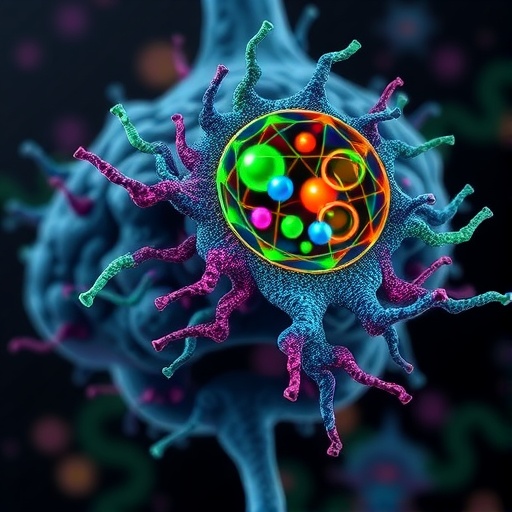In a groundbreaking convergence of multi-omics and single-cell sequencing technologies, researchers have unveiled unprecedented insights into the molecular orchestration of schizophrenia pathogenesis centered around the gene RERE. This research, spearheaded by Shen and Xiao, delves deeply into the spatiotemporal dynamics of RERE, an emergent player implicated in neurodevelopmental regulation and psychiatric disorders. The findings reveal not only how RERE expression fluctuates across developmental time points but also how its intricate cellular context might contribute to the onset and progression of schizophrenia.
Schizophrenia, a complex psychiatric disorder characterized by hallucinations, delusions, and cognitive disturbances, has long puzzled neuroscientists due to its multifactorial etiology involving genetic, environmental, and epigenetic factors. Decoding the precise molecular and cellular mechanisms underlying the disease’s progression has remained challenging. However, by integrating multi-omics datasets—comprising genomic, transcriptomic, and epigenomic layers—with single-cell resolution sequencing, this study offers a panoramic yet detailed view of schizophrenia’s molecular underpinnings through the lens of RERE dynamics.
RERE, or arginine-glutamic acid dipeptide repeats protein, has not been a primary suspect in schizophrenia research until recent genome-wide association studies hinted at its potential involvement. Located on chromosome 1p36, RERE encodes a nuclear receptor coregulator that modulates gene expression critical for neurodevelopment. The team’s approach involved tracking RERE expression patterns during key developmental windows, using brain tissue samples from cohorts spanning prenatal stages to adulthood, thereby elucidating the gene’s temporal regulation in healthy versus schizophrenic brains.
One of the study’s pivotal revelations is the distinct spatial heterogeneity of RERE expression in specific brain regions known to be disrupted in schizophrenia, such as the prefrontal cortex and hippocampus. Single-cell RNA sequencing illuminated that RERE exhibits cell-type-specific dynamics, with differential expression in excitatory neurons, certain interneuron populations, and glial cells. This heterogeneity underscores the importance of considering cellular context when investigating gene function in psychiatric disorders.
The multi-omics integration further unraveled that alterations in RERE expression correlate with changes in DNA methylation patterns and histone modification states, pointing toward an epigenetic regulatory layer that may influence schizophrenia onset. Notably, changes in enhancer regions associated with RERE’s regulatory network suggested an intricate interplay between genetic and epigenetic factors, potentially triggered by environmental stressors known to exacerbate schizophrenia risk.
Moreover, the findings indicate that aberrant RERE activity may perturb downstream gene networks involved in synaptic plasticity, neuronal migration, and immune signaling—processes fundamental to brain development and function. Perturbations in these pathways could mechanistically bridge the gap between observed genetic variations and clinical phenotypes, offering a mechanistic explanation for some of the hallmark symptoms of schizophrenia.
The authors also explored the temporal sequencing of pathophysiological events, revealing that RERE-associated disruptions manifest early in neurodevelopment, consistent with the neurodevelopmental hypothesis of schizophrenia. This temporal insight suggests that early intervention strategies targeting these molecular pathways could hold transformative therapeutic potential.
Intriguingly, the study leveraged advanced computational frameworks to construct a multi-layered regulatory map positioning RERE as a hub gene in schizophrenia-associated gene regulatory networks. This model predicts how mutations or dysregulations in RERE could cascade through molecular pathways, ultimately leading to the complex symptomatology seen in patients.
Single-cell analyses offered granular resolution into the interplay between RERE and various neuronal subtypes. The research team observed subtype-specific expression patterns that potentially explain the heterogeneous clinical features of schizophrenia, supporting the theory that different neural circuits may be selectively vulnerable in the disorder.
The integration of multi-omics data was not merely descriptive but also predictive. By applying machine learning algorithms, the researchers identified biomarkers linked to RERE dysregulation that could enhance early diagnostic accuracy for schizophrenia, a critical advancement given the disease’s typical late diagnosis.
This study also opens intriguing questions regarding the potential reversibility of schizophrenia-related molecular alterations. Epigenetic modifications, by nature, offer therapeutic windows where pharmacological or behavioral interventions might restore normal RERE function or mitigate downstream effects, highlighting avenues for future translational research.
While RERE emerges as a compelling focal point, the researchers caution that schizophrenia remains a polygenic and multifaceted condition. Therefore, RERE’s contribution should be understood as part of a complex genetic landscape, synergizing with other risk factors to culminate in disease manifestation.
These insights redefine our understanding of schizophrenia’s molecular landscape, positioning RERE not merely as another player but as a master regulator with broad implications for neurodevelopmental integrity and psychiatric health. The application of cutting-edge sequencing and integrative systems biology marks a new era in psychiatric genetics, promising to unravel disease enigmas with unprecedented resolution.
Ultimately, this research heralds a paradigm shift. By dissecting the spatiotemporal dynamics of RERE through multi-omics and single-cell technologies, Shen and Xiao chart a path toward precise molecular stratification of schizophrenia, offering hope for earlier diagnosis, personalized interventions, and novel therapeutic targets that could one day transform patient outcomes.
Subject of Research: Molecular and cellular mechanisms of schizophrenia pathogenesis focusing on the gene RERE.
Article Title: Spatiotemporal dynamics of RERE in schizophrenia pathogenesis: insights from multi-omics and single-cell sequencing.
Article References: Shen, J., Xiao, C. Spatiotemporal dynamics of RERE in schizophrenia pathogenesis: insights from multi-omics and single-cell sequencing. Schizophr (2025). https://doi.org/10.1038/s41537-025-00705-y
Image Credits: AI Generated




